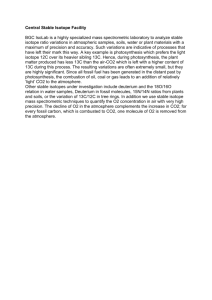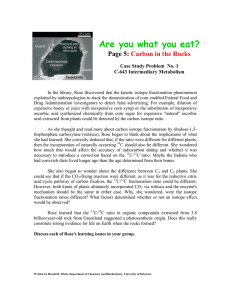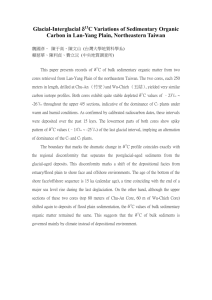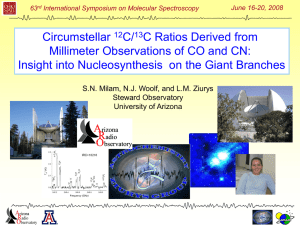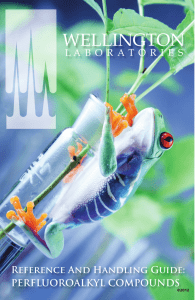1. Carbon Cycle 2. Analytical techniques in chemical oceanography 12.097 Lecture
advertisement
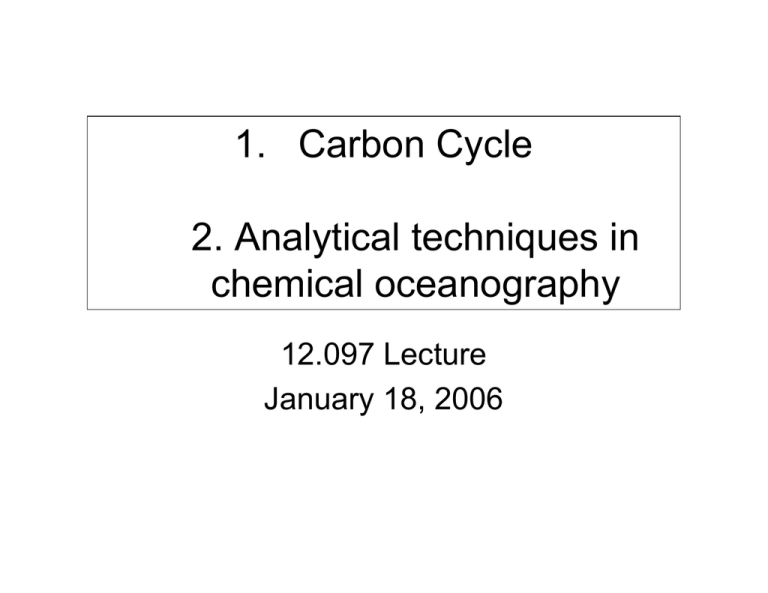
1. Carbon Cycle 2. Analytical techniques in chemical oceanography 12.097 Lecture January 18, 2006 From www.pmel.noaa.gov/co2/gif/ The Marine C Cycle Image removed due to copyright considerations. Please see: Valiela, 1994. (See readings.) DOC distribution Image removed due to copyright considerations. Please see: Williams 2000. (See readings.) Summary depth profile of DOC in open ocean, separated into low and high molecular weight components. Sources of DOC to surface ocean Image removed due to copyright considerations. Please see: Nagata, 2000. (See readings.) What is DOC? Image removed due to copyright considerations. Please see: Williams, 2000. (See readings.) From: http://esd.lbl.gov/CLIMATE/OCEAN/images/observations.gif POC distribution Particulate Organic Carbon (POC) • • Image removed due to copyright considerations. Please see: S. Wakeham (www.skio.peachnet.edu/research/biogeochemlab/) • • • POC falls in episodic “clumps” Cannot be sampled adequately by Niskin bottles – must use (semi-)permanently moored sediment traps Flux: 1-100 mgC / m2 / d Varies seasonally Labile organic matter is transported quickly to ocean floor. Carbon cycle rates Image removed due to copyright considerations. Please see: Williams, 2000. (See readings.) Analytical techniques in chemical oceanography Matt Charette’s lab in Marine Chemistry dept at WHOI Nutrient analyzer • • Lachat nutrient auto-analyzer: measures total dissolved nitrogen (TDN), ammonia, nitrate, nitrite, phosphate, silicate Based on standard spectrophotmetric techniques Metals: ICP-MS 1 H 3 Li 11 Na 19 K 37 Rb 55 Cs 87 Fr 2 He 10 Ne 18 Ar 36 Kr 54 Xe 86 Rn Multicollector ICP-MS 4 Be 12 Mg 20 Ca 38 Sr 56 Ba 88 Ra 21 Sc 39 Y 57 La 89 Ac 22 23 24 Ti V Cr 40 41 42 Zr Nb Mo 72 73 74 Hf Ta W 104 105 106 Rf Ha Sg 25 26 Mn Fe 43 44 Tc Ru 75 76 Re Os 107 108 Ns Hs 27 Co 45 Rh 77 Ir 109 Mt 28 Ni 46 Pd 78 Pt 110 29 Cu 47 Ag 79 Au 111 30 Zn 48 Cd 80 Hg 112 5 B 13 Al 31 Ga 49 In 81 Tl 6 C 14 Si 32 Ge 50 Sn 82 Pb 7 N 15 P 33 As 51 Sb 83 Bi 8 O 16 S 34 Se 52 Te 84 Po 9 F 17 Cl 35 Br 53 I 85 At (113) (114) (115) (116) (117) (118) (119) (120) (121) (154) (155) (156) (157) (158) (159) (160) (161) (162) (163) (164) (165) (166) (167) (168) Lanthanides 58 Ce 59 Pr 60 Nd 61 Pm 62 Sm 63 Eu 64 Gd 65 Tb 66 Dy 67 Ho 68 Er 69 Tm 70 Yb 71 Lu Actinides 90 Th 91 Pa 92 U 93 Np 94 Pu 95 Am 96 Cm 97 Bk 98 Cf 99 Es 100 Fm 101 102 Md No 103 Lr Super-Actinides (122) (123) (124) (125) (126) Figure by MIT OCW. (153) Metals: ICP-MS Image removed due to copyright considerations. Please see: Thermo-Finnigan NEPTUNE/TRITON brochure Organic Carbon Analyses 1 • Bulk analyses: – Elemental analysis Image removed due to copyright considerations. Please see: http://www.uark.edu/ua/isotope/about/elemental_analyzer.jpg • Amt of C, H, or N in solid sample • Used on particulate material or freeze-dried “dissolved” material – Carbon combustion • Amt of C in sample after removal of CO2 • High-temperature combustion (>800oC) • Used for aqueous samples only. Image removed due to copyright considerations. Please see: L. Guo(http://denali.frontier.iarc.uaf.edu/) Organic Carbon Analyses 2 • • Compound-specific analyses require (relatively) large amounts of a single compound: need to concentrate initial sample! Polar compounds: remove water – Analysis by HPLC • Nonpolar compounds: extract with organic solvent or solid organic matrix (SPE) – Analysis by GC • Semi-polar compounds – Change pH of solution to make compound neutral (non-ionic) – Derivatize polar component with non-polar functional group • Mass spectrometry – Used to characterize structure and/or composition of individual molecules From: www.chemterra.com/imgs/hc-mkwfig10.jpg Organic Carbon: Isotopes Overview • There are 3 isotopes of carbon: – – – • 12C: 6 neutrons, 6 protons, stable, 98.89% of all carbon 13C: 7 neutrons, 6 protons, stable, 1.11% of all carbon 14C: 8 neutrons, 6 protons, radioactive, 10-10% Dominant process for determining 13C/12C: fractionation – The small mass difference (approx 1 Da) creates a small (but significant) in energy requirements for bonds between 13C and the more abundant 12C atoms. – Thus, biological systems will preferentially use 12C over 13C, resulting in a decreased 13C/12C in biological material and an increased 13C/12C in the reservoir. 13 13 ⎡ ⎛ ⎞ ⎛ 13 C C⎞ ⎤ – Reported values: δ C ⎟ ⎟ −⎜ ⎜ ⎢ ⎜ 12 ⎟ ⎜ 12C ⎟ ⎥ C ⎠ std ⎥ ⎠ sample ⎝ ⎝ * 1000 ∂13C = ⎢ 13 ⎢ ⎥ ⎛ C⎞ ⎜⎜ 12 ⎟⎟ ⎢ ⎥ ⎝ C ⎠ std ⎢⎣ ⎥⎦ δ13C ratios in environment Image removed due to copyright considerations. Please see: http://basinisotopes.org/basin/tutorial/gifs_2/irms_diagram.html Image removed due to copyright considerations. Please see: http://www.geosc.psu.edu/~dbice/DaveSTELLA/Carbon/c_isotope_models.htm Image removed due to copyright considerations. Please see: http://www.eva.mpg.de/evolution/images/isotope.jpg

